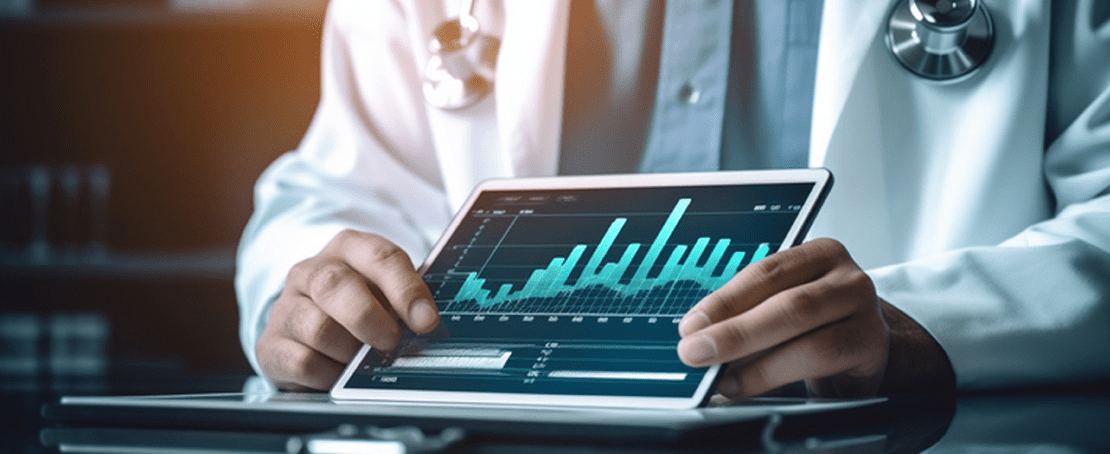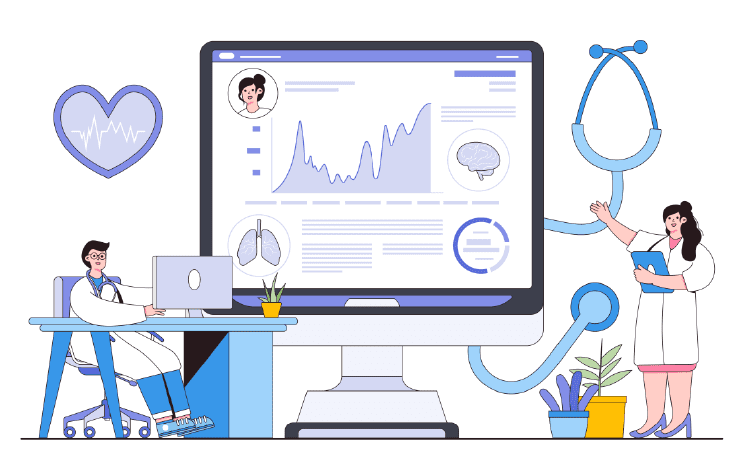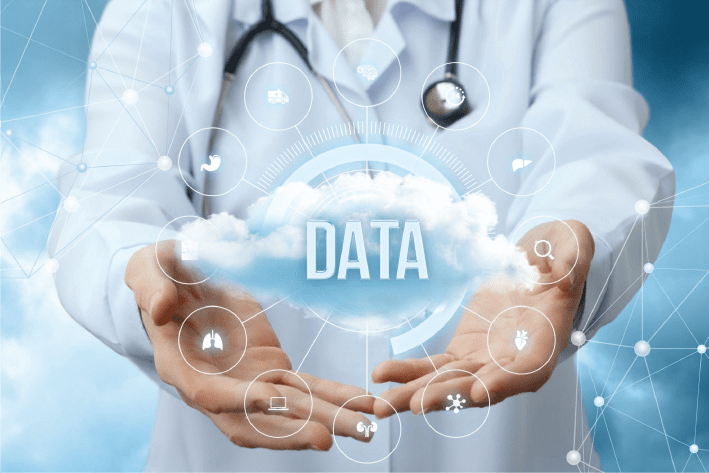- February 15, 2024
- Posted by: Kavitha V Amara
- Category: Industries


In the grand scheme of things, it’s becoming increasingly evident that data is the new black gold. Industries across the board are awakening to the realization that data is no longer just an afterthought or an add-on; it’s an essential component of success. In the 19th century, oil was the lifeblood of the global economy and politics. In the 21st century, data is controlled to take on the same critical role.
Of course, data in its raw and unrefined form is essentially useless. It’s only when data is skillfully gathered, integrated, and analyzed that it starts to unlock its actual value. This value can manifest in many ways, from enhancing decision-making capabilities to enabling entirely new business models. In the healthcare industry, data is playing a particularly pivotal role. Refined data is helping professionals make better-informed decisions, improve patient outcomes, and unlock new frontiers of medical research. The future of healthcare is all about data, and those who know how to wield it will undoubtedly emerge as leaders in the field.
However, healthcare providers’ timely access to real-time or just-in-time information can significantly enhance patient care, optimize clinician efficiency, streamline workflows, and reduce healthcare costs.
Investing in robust electronic health record (EHR) systems encompassing all clinical data is crucial for healthcare organizations to understand patient conditions and comprehensively predict patient outcomes.
Is Data a Real Game Changer in the Healthcare Industry?
The answer to whether the analytical application of existing data will shape the future of healthcare is a resounding “yes.” With advances in data-collecting tools and healthcare technology, we’re witnessing a new era of healthcare delivery that will revolutionize the industry.
Imagine a world where wearable medical devices warn you of potential health risks or medical advice apps offer personalized guidance based on your unique DNA profile. These are just a few examples of how cutting-edge technology is making its way into the healthcare space, enabling data-driven decisions that improve patient outcomes and drive down costs.
Real-time data is a game-changer for case review and clinical time management, allowing healthcare professionals to understand patient situations and forecast outcomes more effectively. To fully realize the potential of data-driven healthcare, healthcare organizations must implement robust data management systems that can store all clinical data and provide the necessary tools for data analysis. By doing so, healthcare professionals will be empowered to make informed decisions that enhance patient care, improve outcomes, and ultimately transform the healthcare landscape.
Also, read the best approach to testing digital healthcare.
How do you use data for a better future?
When it comes to healthcare, data is everything. However, with the massive amounts of data that healthcare professionals must contend with, the sheer volume of information can be overwhelming.
As the industry has shifted toward electronic record keeping, healthcare organizations have had to allocate more resources to purchasing servers and computing power to handle the influx of data. This has led to a significant surge in spending across the sector.
Despite the clear advantages of data-driven healthcare, managing such large amounts of information presents unique challenges. Sorting through and making sense of the data requires robust data management systems and advanced analytical tools. However, with the right approach, healthcare professionals can leverage this data to make informed decisions that improve patient outcomes and transform the industry.
How does data analytics benefit the healthcare industry?

A small diagnostic error can have devastating consequences in the healthcare industry, potentially costing lives. The difference between an actual positive malignant tumor and a benign one can be the difference between life and death. This is where data analytics comes into play, helping to eliminate the potential for error by identifying the most relevant patterns in the available data and predicting the best possible outcome.
Beyond improving patient care, data analytics can also assist hospital administration in evaluating the effectiveness of their medical personnel and treatment processes. As the industry continues to shift toward providing high-quality and reasonable care, the insights derived from data analysis can help organizations stay on the cutting edge of patient care.
With data analytics, healthcare professionals can harness the power of big data to identify patterns and trends, predict patient outcomes, and improve the overall quality of care. Healthcare organizations can optimize their processes by leveraging data-driven insights, minimizing errors, and ultimately delivering better patient outcomes.
Approaches of Data Analytics

Data analytics is a complex process involving various approaches, E.g., predictive analysis, descriptive analysis, and prescriptive analysis, including feature understanding, selection, cleaning, wrangling, and transformation. These techniques are applied depending on the type of data being analyzed.
Analysts must first understand the features and variables relevant to the analysis to derive insights from the data. From there, they can select the most relevant features and begin cleaning and wrangling the data to ensure accuracy and completeness.
Once the data has been prepared, analysts can apply various transformation techniques to derive insights and patterns. The specific methods used will depend on the nature of the data being analyzed but may include methods such as regression analysis, clustering, and decision trees.
Predictive Analysis
Analysts leverage sophisticated techniques such as relational, dimensional, and entity-relationship analysis methodologies to forecast outcomes. By applying these powerful analytical methods, they can extract insights from large and complex datasets, identifying patterns and relationships that might otherwise be obscured.
Whether analyzing patient data to forecast disease progression or studying market trends to predict demand for new medical products, these advanced analytical techniques are essential for making informed decisions in today’s data-driven world. By leveraging the latest tools and techniques, healthcare professionals can stay ahead of the curve, improving patient outcomes and driving innovation in the industry.
Descriptive Analysis
In the data analytics process, descriptive analysis is a powerful technique that can be used to identify trends and patterns in large datasets. Unlike more complex analytical methods, descriptive analysis relies on simple arithmetic and statistics to extract insights from the data.
Analysts can gain a deeper understanding of data distribution by analyzing descriptive statistics such as mean, median, and mode, helping to identify common trends and patterns. This information is invaluable during the data mining phase, assisting analysts to uncover hidden insights and identify opportunities for further analysis.
Prescriptive Analysis
In data analytics, prescriptive analysis represents the pinnacle of analytical techniques. Beyond simple descriptive or predictive analysis, prescriptive analysis offers recommendations for proceeding based on insights gleaned from the data.
This highly advanced analysis is the key to unlocking new opportunities in the healthcare industry, enabling professionals to make more informed decisions about everything from treatment protocols to resource allocation. By leveraging sophisticated algorithms and machine learning techniques, prescriptive analysis can identify the optimal path forward for any situation, helping organizations optimize processes, maximize efficiency, and drive better patient outcomes.
Gathering Real-time Data in Healthcare
Real-time data refers to data that is immediately obtained upon its creation and can be collected using various methods, including:
- Health Records
- Prescriptions
- Diagnostics Data
- Apps and IoTs
Real-time data is crucial for managing the healthcare industry’s patient care, operations, and staffing routines. By leveraging real-time data, the industry can optimize its entire IT infrastructure, gaining greater insight and understanding of its complex networks.
Examples of Real-time Data Technologies in Healthcare
Role of AI/ML in healthcare
Regarding medical diagnostics, the power of data analytics cannot be overstated. Thanks to cutting-edge machine learning and deep learning methods, it’s now possible to analyze medical records and predict future outcomes with unprecedented precision.
Take machine learning, for example. By leveraging this technology, medical practitioners can reduce the risk of human error in the diagnosis process while also gaining new insights into graphic and picture data that could help improve accuracy. Additionally, analyzing healthcare consumption data using machine learning algorithms makes it possible to allocate resources more effectively and reduce waste.
But that’s not all. Deep learning is also a game-changer in the fight against cancer. Researchers have achieved remarkable results by training a model to recognize cancer cells using deep neural networks. By feeding the model a wealth of cancer cell images, it could “memorize” their appearance and use that knowledge to detect cancerous cells in future images accurately. The potential for this technology to save lives is truly staggering.
RPA (Robotic process automation) in healthcare
The potential for RPA in healthcare is fascinating. By scanning incoming data and scheduling appointments based on a range of criteria like symptoms, suspected diagnosis, doctor availability, and location, RPA can dramatically boost efficiency. This would relieve the burden of time-consuming scheduling tasks from the healthcare staff and probably improve patient satisfaction.
In addition to appointment scheduling, RPA can also be used to speed up health payment settlements. By consolidating charges for different services, including testing, medications, food, and doctor fees, into a single, more straightforward payment, healthcare practitioners can save time and avoid billing errors. Plus, if there are any issues with cost or delays, RPA can be set up to email patients with customized reminders.
But perhaps the most exciting use of RPA in healthcare is data analysis. By leveraging this technology to produce insightful analytics tailored to each patient’s needs, healthcare providers can deliver more precise diagnoses and treatment plans. Ultimately, this can lead to better outcomes and an enhanced patient care experience.
Role of Big Data in Healthcare
In today’s world, the healthcare industry needs an innovation that can empower medical practitioners to make informed decisions and ultimately enhance patient outcomes. Big data is the transformative force that can revolutionize how we approach healthcare. With the ability to analyze massive amounts of data from various sources, big data can provide medical practitioners with the insights they need to understand better and treat diseases. By leveraging this data, doctors can develop more targeted treatments and therapies that have the potential to improve patient outcomes drastically.
Beyond the immediate benefits of improved treatment options, big data also plays a vital role in driving new drug development. Through advanced clinical research analysis, big data can predict the efficacy of potential new drugs, making it easier for scientists to identify the most promising candidates for further development. This is just one example of how big data is revolutionizing the way we approach healthcare, and the benefits will only continue to grow as we explore more ways to harness its power.
Finally, big data is helping healthcare practitioners to create focused treatments that are tailored to improve population health. By analyzing population health data, big data can detect patterns and trends that would be impossible to identify through other means. With this information, medical professionals can develop targeted treatments that can be applied on a large scale, ultimately improving health outcomes for entire populations. This is just one of the many ways that big data is changing the way we approach healthcare, and it’s clear that the possibilities are endless. As we continue to explore this transformative technology, there’s no doubt that we’ll discover even more innovative ways to leverage big data to improve health outcomes for patients around the world.
Wrapping Up
In conclusion, real-time data analysis is a transformative force in the healthcare industry that has the potential to revolutionize the way we approach patient care. With the ability to analyze vast amounts of data in real-time, medical practitioners can make faster and more informed decisions, resulting in improved patient outcomes and ultimately saving lives.
From predicting potential health risks to identifying disease outbreaks and monitoring patient progress, real-time data analysis is driving innovation in healthcare and changing the way medical professionals approach treatment. By leveraging cutting-edge technologies and advanced analytics tools, healthcare organizations can collect and analyze data from various sources, including wearable devices, electronic health records, and social media, to better understand patient needs and provide personalized care.
As the healthcare industry continues to evolve, it’s clear that real-time data analysis will play an increasingly important role in delivering better health outcomes for patients worldwide. Real-time data analysis can improve patient care, reduce costs, and save lives by giving medical practitioners the insights they need to make more informed decisions. The possibilities for the future of healthcare services are endless, and I’m excited to see the continued innovations that will arise from this transformative technology.




